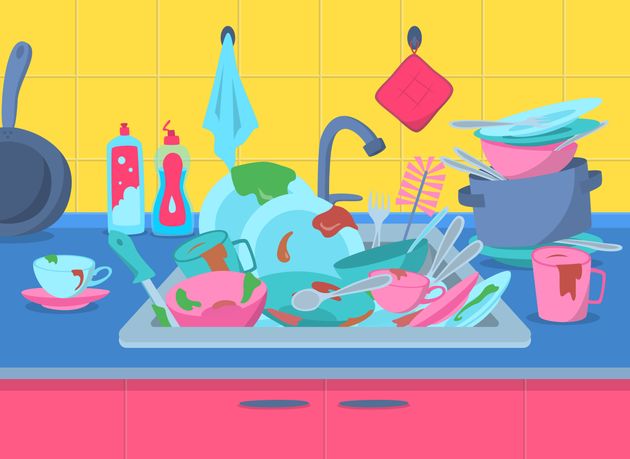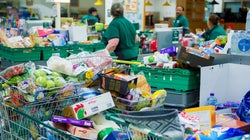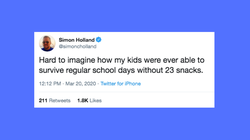Family meals have a long tradition of increasing feelings of closeness and well-being, things that are more important than ever during the coronavirus pandemic. But it’s key to prepare those meals in a clean, coronavirus-free kitchen.
As University of Michigan epidemiologist Aubree Gordon told HuffPost, “It’s really stressful times for everybody. Unless somebody in the home is ill, I would suggest people have family meals together.”
That means more cooking and cleaning. Even when you’re not gathered around the table, it’s likely everybody will be in and out of the kitchen all day snacking or getting drinks.
Here are some experts’ tips on keeping your kitchen clean and safe during this time. Please note that this advice is only for households in which everybody is currently healthy and free of Covid-19, the illness caused by the virus.

Clean The Kitchen More Than Once A Day
“With everybody working and studying from home right now, you’re going to need to clean the kitchen a couple of times a day. The good news is smart, targeted hygiene works,” said Brian Sansoni, senior vice president of communications at the American Cleaning Institute.
There is some evidence in simulated experiments — such as this one published by the New England Journal of Medicine — that the coronavirus may remain viable for hours to days on surfaces, and it’s possible someone might unknowingly have brought it into the house.
The virus, officially dubbed SARS-CoV-2, is thought to be more stable on plastic and stainless steel than on copper and cardboard. It might survive on plastic and stainless steel for up to 72 hours.
The most important rule: Clean first. According to chemist William F. Carroll Jr. of Indiana University, “Cleaning removes dirt and the organisms that cling to dirt.” Clean all commonly used surfaces: your kitchen counter, a table if you have an eat-in-kitchen, refrigerator door handles, cutting boards, stove knobs and cabinet doors. Make a checklist of places to clean and keep it handy — on a refrigerator door with a magnet, for instance. Simple soap and water will do. To clean your sponge at the end of the day, Carroll says to simply put it in the dishwasher with your dishes.
The next step is to disinfect. Carroll is a “big bleach guy, on surfaces that can tolerate bleach. Just be sure the room has adequate ventilation.” First, remember that bleach expires, so check the expiration date on your bottle to make sure it’s current. According to the Centers for Disease Control and Prevention, diluted bleach, hydrogen peroxide or 70% isopropyl alcohol effectively kill coronavirus. You can make your own solution and use paper towels, or if you don’t like spraying product, you can buy commercial wipes or sanitisers. The CDC suggests mixing 4 teaspoons of bleach per quart of water. Let it sit for one minute on the surface until you dry it off.
The good news? Coronavirus is vulnerable to disinfectants and soap. The virus has a lipid (fatty) outer membrane surrounding it that is easily disrupted by soap and water, and by many disinfectants. It appears to survive for days on a surface, at most, not for weeks like norovirus, the virus responsible for some stomach flus.
Vinegar is great, but it’s not a bonafide disinfectant. You can use it to clean, but not to sanitise.Vinegar is ineffective against most bacteria and viruses, including coronavirus. Vodka, which is only 40% alcohol, won’t work, either.
Wipes and solutions that you spray on a surface are equally effective, Carroll said. However, there has been a stampede to buy products like wipes, so it’s a good idea to have solutions stocked and ready to go under the sink.
Be aware of the time a disinfectant needs to stay on a surface while air-drying. Sansoni notes that you should “read the product label on all disinfectants and wipes, because they have instructions on letting the surface stay wet or air dry for a certain amount of time, which varies by product.”
Some products may require 30 seconds to dry, others may need as long as a few minutes. You can find product guidelines here, along with a link to sanitising products approved by the Environmental Protection Agency for coronavirus.
Disposable gloves are fine. If you have gloves and want to wear them, that’s fine, Carroll said. If you don’t wear gloves, then wash your hands thoroughly when done (see below).
Consider disinfecting nonporous containers. Because of the research mentioned above, there’s always the chance a nonporous (glass and metal) container could have been handled by someone with the virus — including a stocking person at the store. You can use the same disinfectant wipes or solution to clean cans, bottles and jars.
Transfer some foods to clean containers. For foods like whole grains, dried beans, pasta, cereals and other similar items, you may want to transfer them to clean containers. That way you don’t have to worry about the small chance of a virus lurking on the container the food came in.
Run your dishwasher on the sanitiser setting if you have it. Machines with a sanitiser setting reach an internal temperature of 155 degrees Fahrenheit, which is tough for a virus to survive.
You can just leave containers and packages in a designated corner of the kitchen or inside a cabinet for three days if you don’t have time to disinfect them, Gordon said. Cardboard is not a great host for the virus: “We know that concentration of live virus decreases relatively rapidly on cardboard.”
For produce, just rinse it as usual. “You do not need to soak your produce in a sanitising solution,” Gordon said. There are no known instances of produce or food itself transferring the virus, according to the European Food Safety Authority. Respiratory viruses do not tend to reproduce via the digestive tract, according to this study.
Wash your hands thoroughly. Once you’ve finished cleaning, wash your hands thoroughly with soap and water for at least 20 seconds.
Dry your clean hands on a clean towel. “Remember not to wipe dirty hands on a clean towel,” Carroll reminds us, “and make sure all the other family members do the same.” If you have kids or a spouse who forgets this rule, keep your own stock of clean towels for use after kitchen cleanup.


